An Assessment of the Security of China’s Natural Gas Supply System Using Two Network Models
Abstract
:1. Introduction
2. Literature Review of Analysis of Natural Gas Supply System
3. Methodology
3.1. The Concerns of Natural Gas Supply Security
3.2. Data Sources
3.3. An Ecological Network Model of China’s Natural Gas Supply System
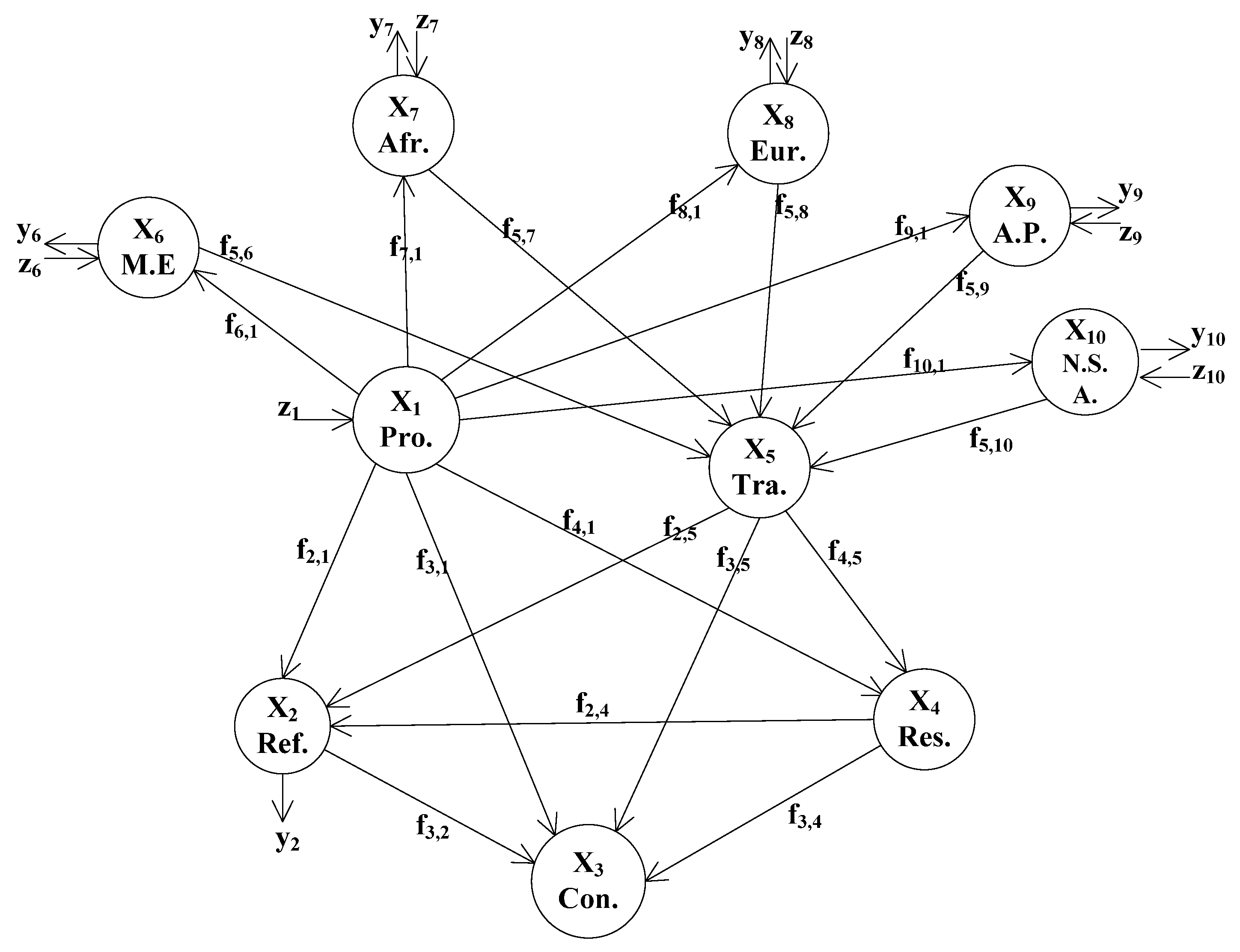
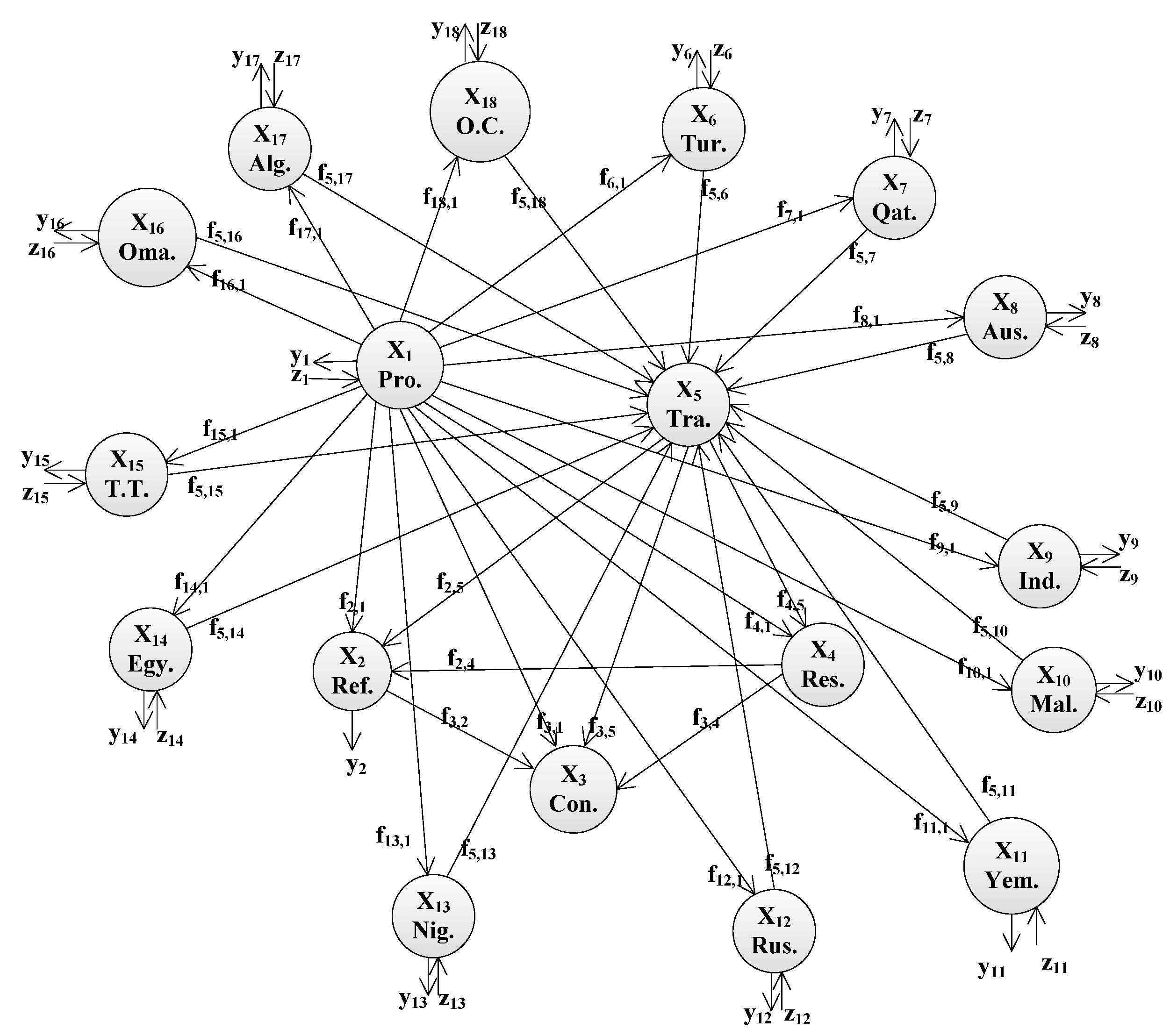
3.4. Network Information Analysis
3.5. Network Structure Analysis
3.6. Network Properties
3.6.1. Network Synergism and Mutualism
| Signs | Relationship | Signs | Relationship | Signs | Relationship |
|---|---|---|---|---|---|
| (+, +) | mutualism | (+, −) | exploitation | (−, +) | altruism |
| (−, −) | competition | (+, 0) | anabolism | (0, +) | commensalism |
| (−, 0) | catabolism | (0, −) | amensalism | (0, 0) | neutralism |
3.6.2. The Dominance of Indirect Effects
3.6.3. Network Homogenization
4. Results and Discussion
4.1. Overall Security Level of China’s Natural Gas Supply System
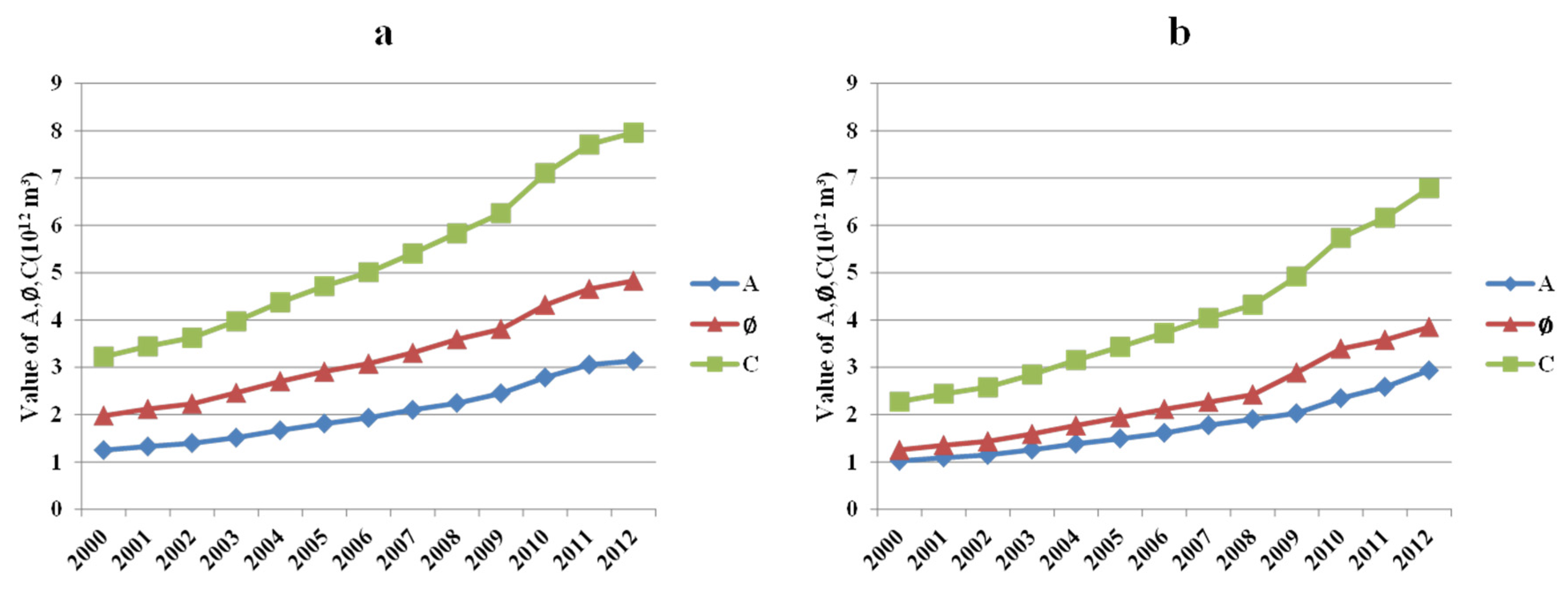
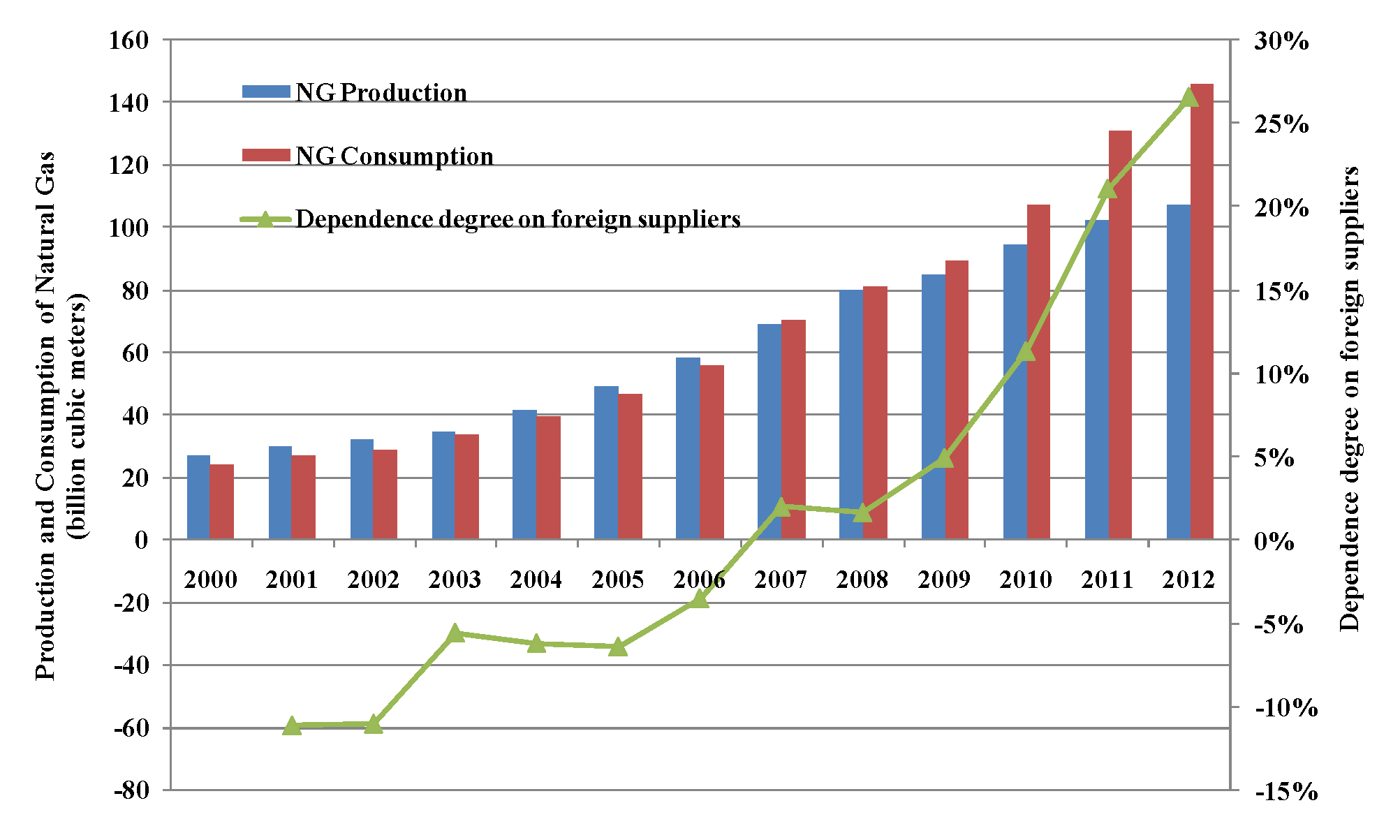
| Parameters of the Network | Regional Layer (RL) | National Layer (NL) |
|---|---|---|
| N | 10 | 18 |
| L | 31 | 64 |
| Connectivity (L/N2) | 0.31 | 0.1975309 |
| Link density (L/N) | 3.1 | 3.5555556 |
4.2. The Structure of China’s Natural Gas Supply System

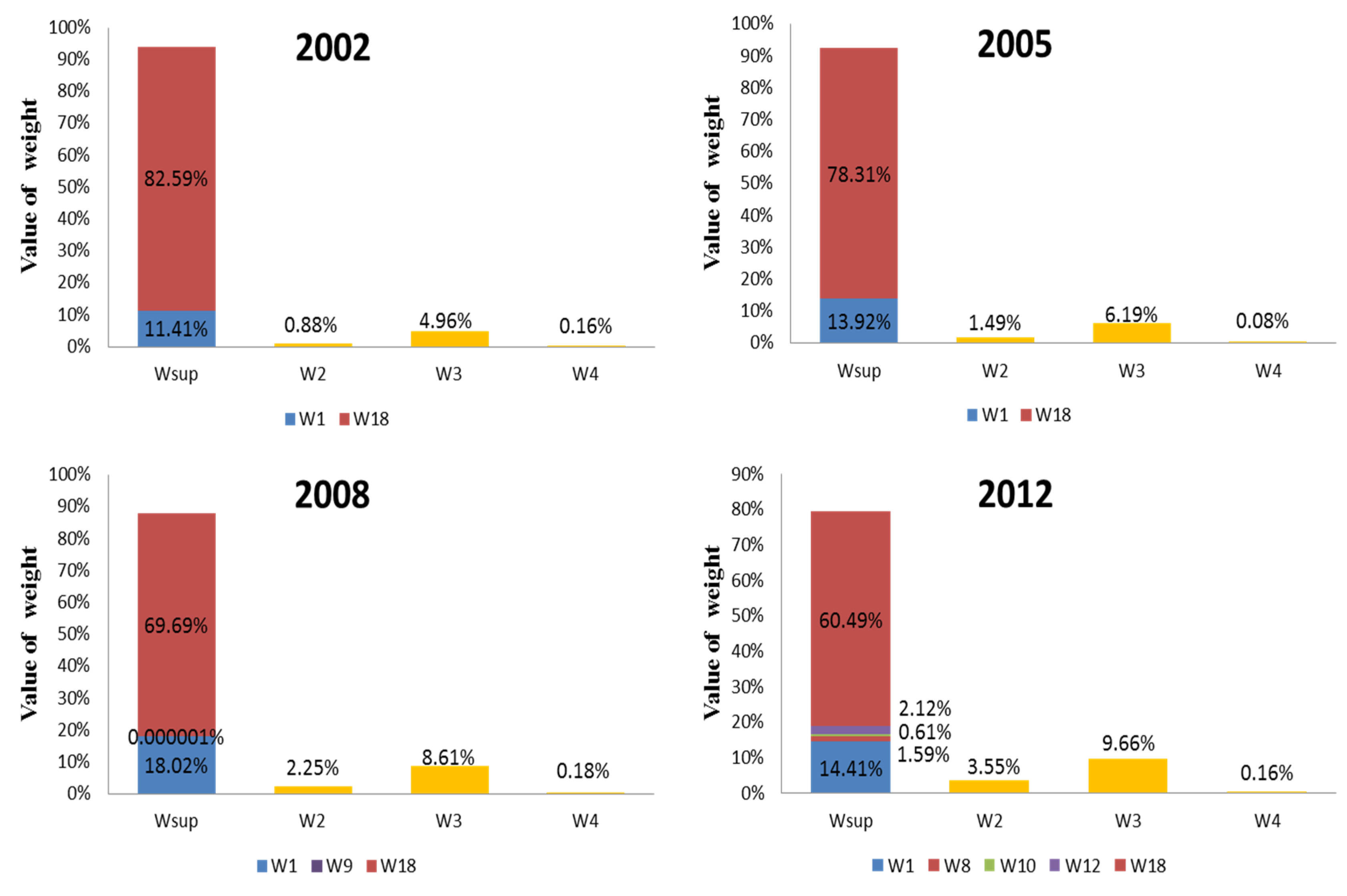
4.3. The Properties of China’s Natural Gas Supply System

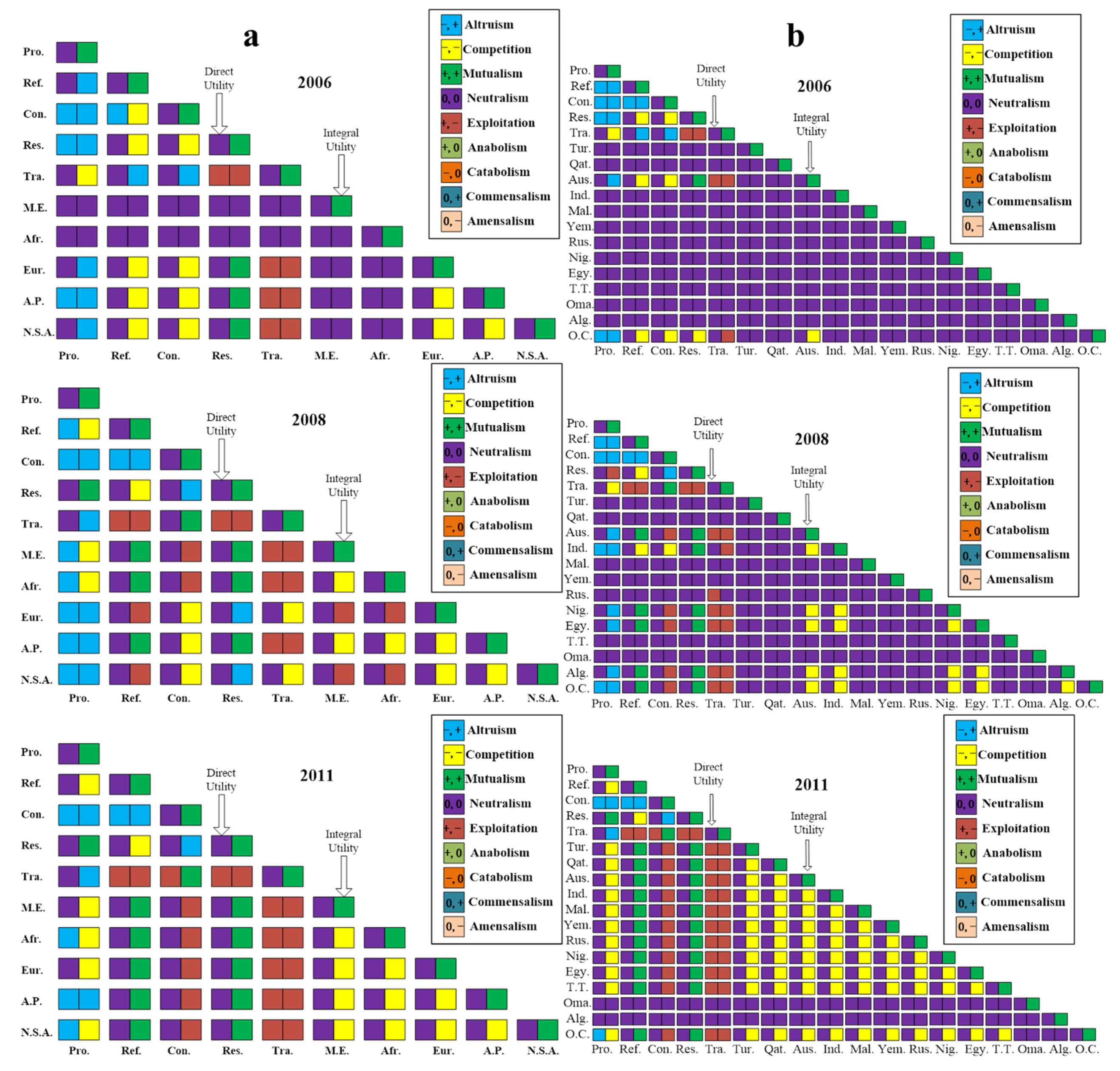
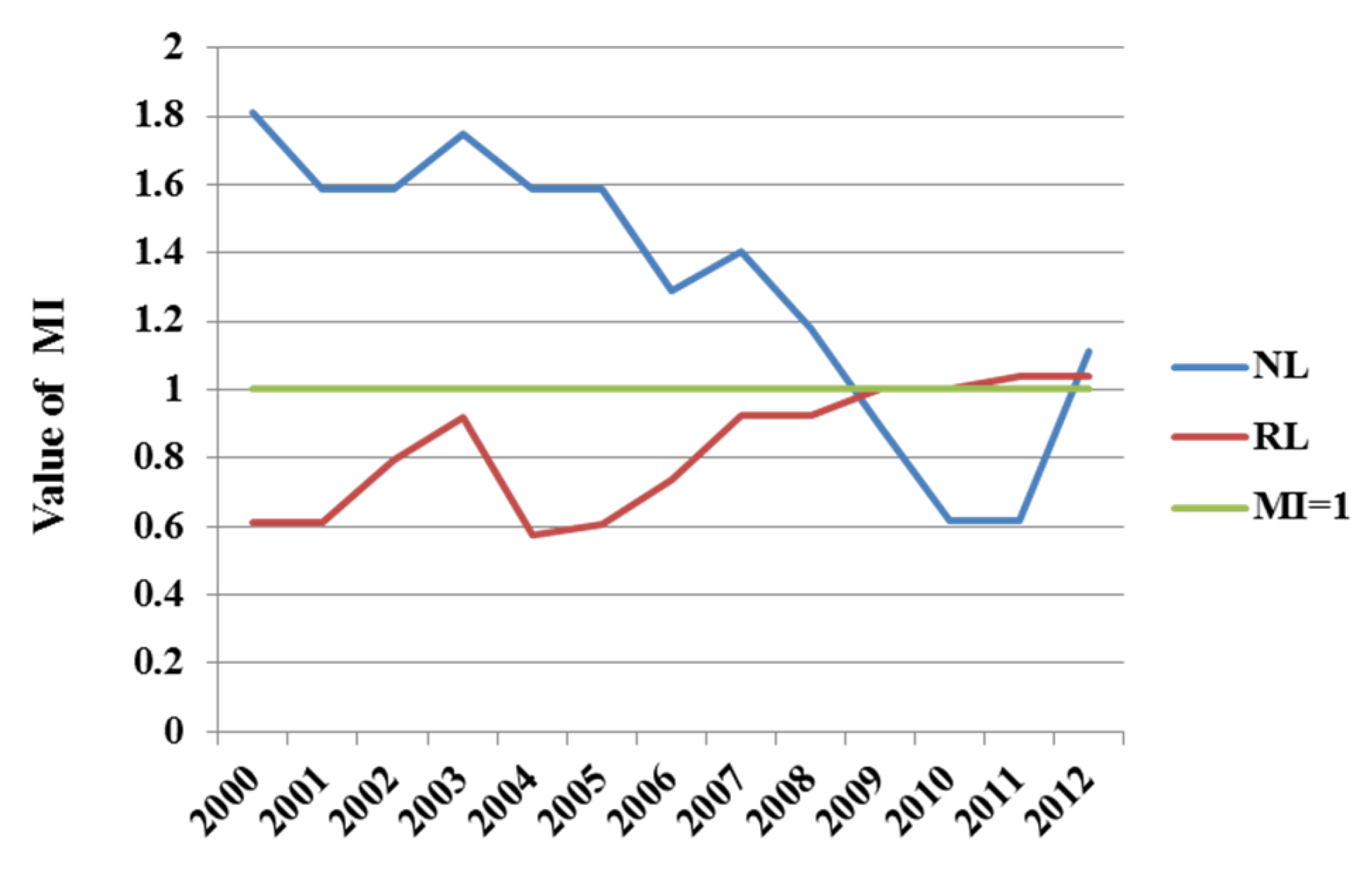
5. Conclusions
Acknowledgments
Author Contributions
Conflicts of Interest
References
- World Energy Outlook 2014; International Energy Agency: Paris, France, 2014; Available online: https://www.iea.org/publications/freepublications/publication/WEO_2014_ES_English_WEB.pdf (accessed on 5 October 2015).
- Energy Statistics Division, National Bureau of Statistics. The China Energy Statistical Yearbooks (2000–2002); China Statistics Press: Beijing, China, 2004; Available online: http://tongji.cnki.net/kns55/Navi/YearBook.aspx?id=N2006050897&floor=1 (accessed on 1 December 2015).
- Energy Statistics Division, National Bureau of Statistics. The China Energy Statistical Yearbooks (2004); China Statistics Press: Beijing, China, 2005; Available online: http://tongji.cnki.net/kns55/Navi/YearBook.aspx?id=N2006050898&floor=1 (accessed on 1 December 2015).
- Energy Statistics Division, National Bureau of Statistics. The China Energy Statistical Yearbooks (2005); China Statistics Press: Beijing, China, 2006; Available online: http://tongji.cnki.net/kns55/Navi/YearBook.aspx?id=N2009100028&floor=1 (accessed on 1 December 2015).
- Energy Statistics Division, National Bureau of Statistics. The China Energy Statistical Yearbooks (2006); China Statistics Press: Beijing, China, 2007; Available online: http://tongji.cnki.net/kns55/Navi/YearBook.aspx?id=N2009100078&floor=1 (accessed on 1 December 2015).
- Energy Statistics Division, National Bureau of Statistics. The China Energy Statistical Yearbooks (2007); China Statistics Press: Beijing, China, 2008; Available online: http://tongji.cnki.net/kns55/Navi/YearBook.aspx?id=N2008070077&floor=1 (accessed on 1 December 2015).
- Energy Statistics Division, National Bureau of Statistics. The China Energy Statistical Yearbooks (2008); China Statistics Press: Beijing, China, 2008; Available online: http://tongji.cnki.net/kns55/Navi/YearBook.aspx?id=N2009060138&floor=1 (accessed on 1 December 2015).
- Energy Statistics Division, National Bureau of Statistics. The China Energy Statistical Yearbooks (2009); China Statistics Press: Beijing, China, 2010; Available online: http://tongji.cnki.net/kns55/Navi/YearBook.aspx?id=N2010080088&floor=1 (accessed on 1 December 2015).
- Energy Statistics Division, National Bureau of Statistics. The China Energy Statistical Yearbooks (2010); China Statistics Press: Beijing, China, 2011; Available online: http://tongji.cnki.net/kns55/Navi/YearBook.aspx?id=N2011030123&floor=1 (accessed on 1 December 2015).
- Energy Statistics Division, National Bureau of Statistics. The China Energy Statistical Yearbooks (2011); China Statistics Press: Beijing, China, 2011; Available online: http://tongji.cnki.net/kns55/Navi/YearBook.aspx?id=N2012020066&floor=1 (accessed on 1 December 2015).
- Energy Statistics Division, National Bureau of Statistics. The China Energy Statistical Yearbooks (2012); China Statistics Press: Beijing, China, 2012; Available online: http://tongji.cnki.net/kns55/Navi/YearBook.aspx?id=N2013020081&floor=1 (accessed on 1 December 2015).
- Energy Statistics Division, National Bureau of Statistics. The China Energy Statistical Yearbooks (2013); China Statistics Press: Beijing, China, 2013; Available online: http://tongji.cnki.net/kns55/Navi/YearBook.aspx?id=N2014030143&floor=1 (accessed on 1 December 2015).
- Lin, B.; Jiang, Z. Estimates of energy subsidies in China and impact of energy subsidy reform. Energy Econ. 2011, 33, 273–283. [Google Scholar] [CrossRef]
- Lin, B.Q.; Wesseh, P.K. Energy consumption and economic growth in South Africa reexamined: A nonparametric testing apporach. Renew. Sustain. Energy Rev. 2014, 40, 840–850. [Google Scholar] [CrossRef]
- Sagen, E.L.; Tsygankova, M. Russian natural gas exports—Will Russian gas price reforms improve the European security of supply? Energy Policy 2008, 36, 867–880. [Google Scholar] [CrossRef]
- Kaliski, M.; Siemek, J.; Sikora, A.; Szurlej, A. Possible Scenarios of the European Union Energy Policy Versus Stable Deliveries of Natural Gas to Central and Eastern Europe Based on the Russian Energy Policy. Rynek Energii 2009, 3, 2–12. [Google Scholar]
- Chen, J.L.; Shan, Q. Access Pricing Policy Reform Suggestions in China’s Natural Gas Pipeline Industry Based on the Experiences in America. Adv. Mater. Res. 2014, 869, 443–447. [Google Scholar] [CrossRef]
- Bilgin, M. Scenarios on European energy security: Outcomes of natural gas strategy in 2020. Futures 2011, 43, 1082–1090. [Google Scholar] [CrossRef]
- Damigos, D.; Tourkolias, C.; Diakoulaki, D. Households’ willingness to pay for safeguarding security of natural gas supply in electricity generation. Energy Policy 2009, 37, 2008–2017. [Google Scholar] [CrossRef]
- Fubara, T.; Cecelja, F.; Yang, A. Model-based Assessment of the Role of Natural Gas-based Micro-CHP in Residential Energy Supply Systems. In Computer Aided Chemical Engineering; Andrzej, K., Ilkka, T., Eds.; Elsevier: Amsterdam, The Netherlands, 2013; Volume 32, pp. 343–348. [Google Scholar]
- Wright, P. Liberalisation and the security of gas supply in the UK. Energy Policy 2005, 33, 2272–2290. [Google Scholar] [CrossRef]
- Chaudry, M.; Skea, J.; Wang, X.; Jenkins, N. Modelling UK energy system response to natural gas supply infrastructure failures. Proc. Inst. Mech. Eng. A J. Power Energy 2012, 226, 501–513. [Google Scholar] [CrossRef]
- Lochner, S.; Dieckhoner, C. Civil unrest in North Africa-Risks for natural gas supply? Energy Policy 2012, 45, 167–175. [Google Scholar] [CrossRef]
- Wang, J.L.; Feng, L.Y.; Zhao, L.; Snowden, S. China’s natural gas: Resources, production and its impacts. Energy Policy 2013, 55, 690–698. [Google Scholar] [CrossRef]
- Zhou, Q.M.; Dilmore, R.; Kleit, A.; Wang, J.Y. Evaluating gas production performances in marcellus using data mining technologies. J. Nat. Gas Sci. Eng. 2014, 20, 109–120. [Google Scholar] [CrossRef]
- Huang, S.J.; Zhang, H.; Shang, C.J.; Jing, S.L. Key Technologies of Rebuilding Underground Natural Gas Storages from Carbonate Buried Hill Gas Reservoirs. Adv. Mater. Res. 2012, 347, 1561–1567. [Google Scholar] [CrossRef]
- Bilgin, M. Geopolitics of European natural gas demand: Supplies from Russia, Caspian and the Middle East. Energy Policy 2009, 37, 4482–4492. [Google Scholar] [CrossRef]
- Abada, I.; Massol, O. Security of supply and retail competition in the European gas market: Some model-based insights. Energy Policy 2011, 39, 4077–4088. [Google Scholar] [CrossRef]
- Zhao, S.R.; Cheng, S.P. Study on China’s Natural Gas Industry Development Strategy under the Framework of International Energy Security Cooperation-Taking Natural Gas Industry in Sichuan Province as an Example. In Proceedings of the 2012 International Conference on Management Science & Engineering, Dallas, TX, USA, 20–22 September 2012; pp. 1686–1691.
- Vonlanzenauer, C.H.; James, W.G.; Wright, D.D. Insufficient Supply in a Natural Gas Distribution System: A Risk Analysis. Eur. J. Oper. Res. 1992, 56, 41–53. [Google Scholar] [CrossRef]
- Erdogdu, E. Bypassing Russia: Nabucco project and its implications for the European gas security. Renew. Sustain. Energy Rev. 2010, 14, 2936–2945. [Google Scholar] [CrossRef]
- Chedid, R.; Kobrosly, M.; Ghajar, R. A supply model for crude oil and natural gas in the Middle East. Energy Policy 2007, 35, 2096–2109. [Google Scholar] [CrossRef]
- Hamedi, M.; Zanjirani Farahani, R.; Husseini, M.M.; Esmaeilian, G.R. A distribution planning model for natural gas supply chain: A case study. Energy Policy 2009, 37, 799–812. [Google Scholar] [CrossRef]
- Chi, K.C.; Nuttall, W.J.; Reiner, D.M. Dynamics of the UK natural gas industry: System dynamics modelling and long-term energy policy analysis. Technol. Forecast. Soc. Chang. 2009, 76, 339–357. [Google Scholar]
- Sun, J.C.; Lv, D.; Wu, F. The simulated system dynamics analysis of the natural gas supply and demand. Kybernetes 2010, 39, 1262–1269. [Google Scholar]
- Li, J.C.; Dong, X.C.; Shangguan, J.X.; Hook, M. Forecasting the growth of China’s natural gas consumption. Energy 2011, 36, 1380–1385. [Google Scholar] [CrossRef]
- Jansen, J.C.; van Arkel, W.; Boots, M.G. Designing Indicators of Long-Term Energy Supply Security; Energy Research Centre of Netherlands: Petten, The Netherlands, 2004. [Google Scholar]
- Johnson, C.; Boersma, T. Energy (in)security in Poland the case of shale gas. Energy Policy 2013, 53, 389–399. [Google Scholar] [CrossRef]
- Szikszai, A.; Monforti, F. GEMFLOW: A time dependent model to assess responses to natural gas supply crises. Energy Policy 2011, 39, 5129–5136. [Google Scholar] [CrossRef]
- Weisser, H. The security of gas supply—A critical issue for Europe? Energy Policy 2007, 35, 1–5. [Google Scholar] [CrossRef]
- He, C.L.; Zhou, G.D. Safe supply of natural gas in China under global environment. Nat. Gas Ind. 2010, 30, 123–126. (In Chinese) [Google Scholar]
- Downs, E.S. China and the global energy crisis: Development and prospects for China’s oil and natural gas. China Q. 2007, 191, 762–763. [Google Scholar]
- Patten, B.C. Systems Approach to the Concept of Environment. Ohio J. Sci. 1978, 7, 206–222. [Google Scholar]
- Fath, B.D.; Patten, B.C. Review of the foundations of network environ analysis. Ecosystems 1999, 2, 167–179. [Google Scholar] [CrossRef]
- Latham, L.G. Network flow analysis algorithms. Ecol. Model. 2006, 192, 586–600. [Google Scholar] [CrossRef]
- Huang, J.; Ulanowicz, R.E. Ecological Network Analysis for Economic Systems: Growth and Development and Implications for Sustainable Development. PLoS ONE 2014, 9. [Google Scholar] [CrossRef]
- Zhang, Y.; Zheng, H.M.; Fath, B.D.; Liu, H.; Yang, Z.F.; Liu, G.Y.; Su, M.R. Ecological network analysis of an urban metabolic system based on input-output tables: Model development and case study for Beijing. Sci. Total Environ. 2014, 468, 642–653. [Google Scholar] [CrossRef] [PubMed]
- Small, G.E.; Sterner, R.W.; Finlay, J.C. An Ecological Network Analysis of nitrogen cycling in the Laurentian Great Lakes. Ecol. Model. 2014, 293, 150–160. [Google Scholar] [CrossRef]
- Baird, D.; Fath, B.D.; Ulanowicz, R.E.; Asmus, H.; Asmus, R. On the consequences of aggregation and balancing of networks on system properties derived from ecological network analysis. Ecol. Model. 2009, 220, 3465–3471. [Google Scholar] [CrossRef]
- World Energy Outlook 2010; International Energy Agency: Paris, France, 2010; Available online: http://www.worldenergyoutlook.org/weo2010/ (accessed on 1 December 2015).
- General Administration of Customs of the P.R.C. The China Customs Statistics Yearbooks (2001); China Customs: Beijing, China, 2001; pp. 1657–2930.
- General Administration of Customs of the P.R.C. The China Customs Statistics Yearbooks (2002); China Customs: Beijing, China, 2002; pp. 1554–3202.
- General Administration of Customs of the P.R.C. The China Customs Statistics Yearbooks (2003); China Customs: Beijing, China, 2004; Available online: http://tongji.cnki.net/kns55/navi/YearBook.aspx?id=N2013040092&floor=1 (accessed on 1 December 2015).
- General Administration of Customs of the P.R.C. The China Customs Statistics Yearbooks (2004); China Customs: Beijing, China, 2005; Available online: http://tongji.cnki.net/kns55/navi/YearBook.aspx?id=N2013040093&floor=1 (accessed on 1 December 2015).
- General Administration of Customs of the P.R.C. The China Customs Statistics Yearbooks (2005); China Customs: Beijing, China, 2006; Available online: http://tongji.cnki.net/kns55/navi/YearBook.aspx?id=N2013040094&floor=1 (accessed on 1 December 2015).
- General Administration of Customs of the P.R.C. The China Customs Statistics Yearbooks (2006); China Customs: Beijing, China, 2007; Available online: http://tongji.cnki.net/kns55/navi/YearBook.aspx?id=N2013040095&floor=1 (accessed on 1 December 2015).
- General Administration of Customs of the P.R.C. The China Customs Statistics Yearbooks (2007); China Customs: Beijing, China, 2008; Available online: http://tongji.cnki.net/kns55/navi/YearBook.aspx?id=N2013040096&floor=1 (accessed on 1 December 2015).
- General Administration of Customs of the P.R.C. The China Customs Statistics Yearbooks (2008); China Customs: Beijing, China, 2009; Available online: http://tongji.cnki.net/kns55/navi/YearBook.aspx?id=N2013040097&floor=1 (accessed on 1 December 2015).
- General Administration of Customs of the P.R.C. The China Customs Statistics Yearbooks (2009); China Customs: Beijing, China, 2010; Available online: http://tongji.cnki.net/kns55/navi/YearBook.aspx?id=N2013040098&floor=1 (accessed on 1 December 2015).
- General Administration of Customs of the P.R.C. The China Customs Statistics Yearbooks (2010); China Customs: Beijing, China, 2011; Available online: http://tongji.cnki.net/kns55/navi/YearBook.aspx?id=N2013040099&floor=1 (accessed on 1 December 2015).
- General Administration of Customs of the P.R.C. The China Customs Statistics Yearbooks (2011); China Customs: Beijing, China, 2012; Available online: http://tongji.cnki.net/kns55/navi/YearBook.aspx?id=N2013050023&floor=1 (accessed on 1 December 2015).
- General Administration of Customs of the P.R.C. The China Customs Statistics Yearbooks (2012); China Customs: Beijing, China, 2013; pp. 1657–4924.
- General Administration of Customs of the P.R.C. The China Customs Statistics Yearbooks (2013); China Customs: Beijing, China, 2013; pp. 1945–5796.
- British Petroleum Company. BP Statistical Review of World Energy (2001–2013). Available online: http://www.bp.com/en/global/corporate.html (accessed on 1 December 2015).
- Ulanowicz, R.E.; Goerner, S.J.; Lietaer, B.; Gomez, R. Quantifying sustainability: Resilience, efficiency and the return of information theory. Ecol. Complex. 2009, 6, 27–36. [Google Scholar] [CrossRef]
- Goerner, S.J.; Lietaer, B.; Ulanowicz, R.E. Quantifying economic sustainability: Implications for free-enterprise theory, policy and practice. Ecol. Econ. 2009, 69, 76–81. [Google Scholar] [CrossRef]
- Hirata, H.; Ulanowicz, R.E. Information Theoretical Analysis of Ecological Networks. Int. J. Syst. Sci. 1984, 15, 261–270. [Google Scholar] [CrossRef]
- Trenbath, B.R. Multispecies cropping systems in India—Predictions of their productivity, stability, resilience and ecological sustainability. Agrofor. Syst. 1999, 45, 81–107. [Google Scholar] [CrossRef]
- Walker, B.H.; Anderies, J.M.; Kinzig, A.P.; Ryan, P. Exploring resilience in social-ecological systems through comparative studies and theory development: Introduction to the special issue. Ecol. Soc. 2006, 11, 12. Available online: http://www.ecologyandsociety.org/vol11/iss1/art12/. [Google Scholar]
- Zhang, Y.; Yang, Z.F.; Fath, B.D. Ecological network analysis of an urban water metabolic system: Model development, and a case study for Beijing. Sci. Total Environ. 2010, 408, 4702–4711. [Google Scholar] [CrossRef] [PubMed]
- Holling, C.S. The resilience of terrestrial ecosystems: Local surprise and global change. Sustain. Dev. Biosph. 1986, 1986, 292–317. [Google Scholar]
- Zhang, Y.; Yang, Z.F.; Fath, B.D.; Li, S.S. Ecological network analysis of an urban energy metabolic system: Model development, and a case study of four Chinese cities. Ecol. Model. 2010, 221, 1865–1879. [Google Scholar] [CrossRef]
- Patten, B.C. Network ecology: Indirect determination of the life-environment relationship inecosystems. In Theoretical Studiesof Ecosystems: The Network Perspective; Higashi, M., Burns, T.P., Eds.; Cambridge University Press: Cambridge, UK, 1991; pp. 288–351. [Google Scholar]
- Fath, B.D. Network mutualism: Positive community-level relations in ecosystems. Ecol. Model. 2007, 208, 56–67. [Google Scholar] [CrossRef]
- Wootton, J.T.; Emmerson, M. Measurement of interaction strength innature. Annu. Rev. Ecol. Evol. Syst. 2005, 36, 419–444. [Google Scholar] [CrossRef]
- Patten, B.C. Energy, Emergy and Environs. Ecol. Model. 1992, 62, 29–69. [Google Scholar] [CrossRef]
- Patten, B.C.; Higashi, M.; Burns, T.P. Trophic dynamics in ecosystem networks: Significance of cycles and storage. Ecol. Model. 1990, 51, 1–28. [Google Scholar] [CrossRef]
- Dong, X.C.; Guo, J.; Hook, M.; Pi, G.L. Sustainability Assessment of the Natural Gas Industry in China Using Principal Component Analysis. Sustainability 2015, 7, 6102–6118. [Google Scholar] [CrossRef]
- Shi, G.H.; Jing, Y.Y.; Wang, S.L.; Zhang, X.T. Development status of liquefied natural gas industry in China. Energy Policy 2010, 38, 7457–7465. [Google Scholar] [CrossRef]
© 2015 by the authors; licensee MDPI, Basel, Switzerland. This article is an open access article distributed under the terms and conditions of the Creative Commons by Attribution (CC-BY) license (http://creativecommons.org/licenses/by/4.0/).
Share and Cite
Zhang, M.; Su, M.; Lu, W.; Su, C. An Assessment of the Security of China’s Natural Gas Supply System Using Two Network Models. Energies 2015, 8, 13710-13725. https://doi.org/10.3390/en81212392
Zhang M, Su M, Lu W, Su C. An Assessment of the Security of China’s Natural Gas Supply System Using Two Network Models. Energies. 2015; 8(12):13710-13725. https://doi.org/10.3390/en81212392
Chicago/Turabian StyleZhang, Mingqi, Meirong Su, Weiwei Lu, and Chunhua Su. 2015. "An Assessment of the Security of China’s Natural Gas Supply System Using Two Network Models" Energies 8, no. 12: 13710-13725. https://doi.org/10.3390/en81212392
APA StyleZhang, M., Su, M., Lu, W., & Su, C. (2015). An Assessment of the Security of China’s Natural Gas Supply System Using Two Network Models. Energies, 8(12), 13710-13725. https://doi.org/10.3390/en81212392





